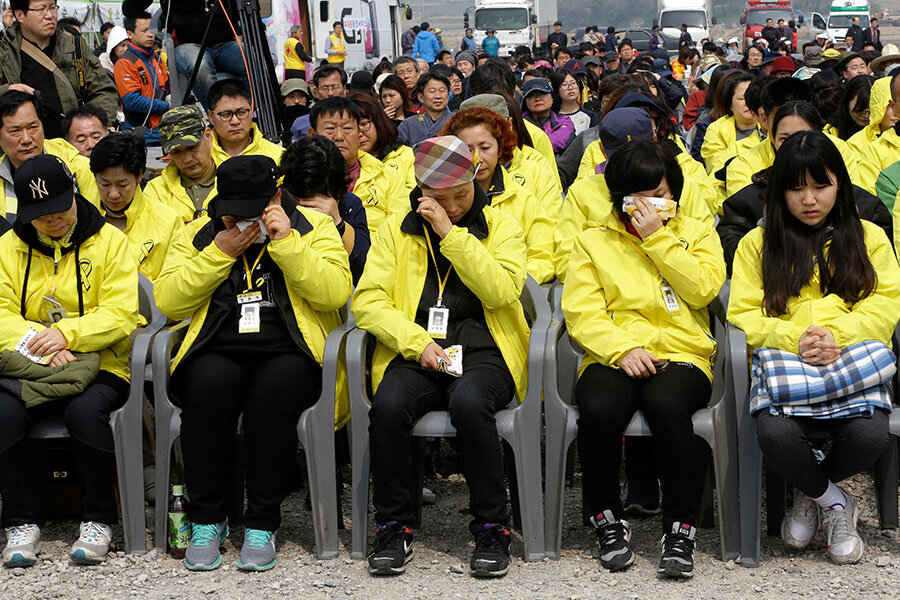Sewol ferry disaster: A year later, South Koreans search for solace
Loading...
| Seoul, South Korea
It has been a year since Park Eun-mi lost her daughter in a ferry sinking that cost 304 lives and unleashed profound soul-searching across the country.
Ms. Park has found little solace in the passing of time since the tragedy, one of South Korea’s worst peacetime disasters. The body of her 17-year-old daughter, Huh Da-yoon, remains lost at sea along with the remains of eight others – all victims of a school trip gone horribly wrong.
“I have been coming out here to picket to say to the president, ‘Please find my daughter,’” Park says outside the Blue House, the official residence of President Park Geun-hye, several days before the April 16th anniversary. "Ms. President, please keep to what you said, your promise.”
Park’s solo protest is one of many continuing reverberations from the ferry sinking. After initially uniting the country in grief, the tragedy swiftly became a source of public anger and shame, and triggered lasting political division and acrimony.
The Korean government called off the search for bodies more than five months ago, citing the increased risk to divers with the onset of winter. Park and other victims' relatives say they were coerced into agreeing to end the search. They accuse the president of failing to keep her promise to find all those who drowned.
Earlier this month, a group of bereaved family members shaved their heads in Seoul’s Gwanghwamun Square in protest at what they saw as the government’s attempts to obstruct an independent inquiry into the disaster.
Unanswered questions
Prosecutors have attributed the sinking to the ferry company's focus on profit over safety, citing abuses such as illegal modifications to the ship and overloading of cargo. The problems allegedly went unchecked because of corrupt dealings between regulators and the ferry company.
Relatives of the victims have long demanded an independent probe into the entire circumstances of the disaster, including the government’s widely criticized rescue and recovery efforts. Only 172 of the ferry’s 476 passengers were rescued alive.
The families also want the ship salvaged, an operation that could cost up to $200 million, according to recent comments by Minister of Oceans and Fisheries Yoo Ji-june. President Park has promised to look into a salvage operation.
Demands for deeper answers persist in part because many Koreans say the Sewol disaster reflects a wider malaise in a country that industrialized at breakneck speed. They ask if South Korea has sacrificed safety and clean business practices in the pursuit of financial gains and economic development.
“The Sewol sinking is not considered an isolated incident because it is seen as having been caused by the problems shared by all sectors of the national economy,” says Se-Woong Koo, editor-in-chief of the polemical news site Korea Exposé.
According to Mr. Koo, those problems include a “disregard for public and worker safety, cutting corners for cost reduction, the culture of ‘pali-pali,’ which means ‘faster and faster,’ the entrenched ties between the business community and the bureaucracy, and above all, the obsession with obvious results at the expense of fundamentals.”
After months of political bickering, Parliament passed a special law in November to set up an independent committee to investigate the disaster. But in recent weeks, the Park administration has attempted to cut the committee’s budget and staff and to appoint public officials to some of its key posts.
The maneuvering has enraged many relatives of the victims. In turn, ruling-party officials have warned that the inquiry was becoming a political weapon and wasting taxpayers’ money.
Demands for accountability
The disaster has long been politically sensitive for President Park, whose approval rating is under 40 percent, compared to over 60 percent before the ferry capsized.
In November, the ferry captain was sentenced to 36 years in prison for gross negligence. Fourteen members of his crew received prison terms of up to 30 years. But Koo says the government is dragging its feet on more fundamental problems.
“Those people are complicit in this disaster, but prosecuting them does not absolve the government of its responsibility to ask bigger questions about the culture that continues to allow loss of human lives through avoidable circumstances,” Koo says.
Meanwhile, Park, the bereaved mother, plans to continue her protest. If the ship is salvaged, she hopes to have the chance to say a proper goodbye to her daughter. But she also has another wish – that a tragedy like Sewol will never be repeated.
“I think this sort of hardship should never happen again,” she says. “I don’t think I could have imagined such hardship.”





